GRACE Combined with WSD to Assess the Change in Drought Severity in Arid Asia
Abstract
:1. Introduction
2. Material and Methods
2.1. Research Data
2.2. GRACE Inversion
2.3. Estimation of Insufficient Water Storage Based on GRACE
3. Study Area
4. Results
4.1. Interannual Variation in TWS in the Arid Area
4.2. Annual TWS Seasonal Variation in the Arid Area
4.3. Analysis of Drought Severity
5. Discussion
5.1. Possible Impacts of Climate Change on Arid Asia
5.2. Uncertainty in Drought Severity Assessment
5.3. WSDI Drought Index Analysis
6. Conclusions
Author Contributions
Funding
Data Availability Statement
Acknowledgments
Conflicts of Interest
References
- Long, D.i.; Scanlon, B.R.; Longuevergne, L.; Sun, A.Y.; Fernando, D.N.; Save, H. GRACE satellite monitoring of large depletion in water storage in response to the 2011 drought in Texas. Geophys. Res. Lett. 2013, 40, 3395–3401. [Google Scholar] [CrossRef] [Green Version]
- Dharpure, J.K.; Goswami, A.; Patel, A.; Kulkarni, A.V.; Meloth, T. Drought characterization using the Combined Terrestrial Evapotranspiration Index over the Indus, Ganga and Brahmaputra river basins. Geocarto Int. 2022, 37, 1059–1083. [Google Scholar] [CrossRef]
- Gerdener, H.; Engels, O.; Kusche, J. A framework for deriving drought indicators from the Gravity Recovery and Climate Experiment (GRACE). Hydrol. Earth Syst. Sci. 2020, 24, 227–248. [Google Scholar] [CrossRef] [Green Version]
- Trenberth, K.E.; Dai, A.; Schrier, G.; Jones, P.D.; Barichivich, J.; Briffa, K.R.; Sheffield, J. Global warming and changes in drought. Nat. Clim. Chang. 2014, 4, 17–22. [Google Scholar] [CrossRef]
- Hu, Z.; Zhou, Q.; Chen, X.; Chen, D.; Li, J.; Guo, M.; Duan, Z. Groundwater Depletion Estimated from GRACE: A Challenge of Sustainable Development in an Arid Region of Central Asia. Remote Sens. 2019, 11, 1908. [Google Scholar] [CrossRef] [Green Version]
- John, W. Time-variable gravity from GRACE: First results. Geophys. Res. Lett. 2004, 31. [Google Scholar] [CrossRef] [Green Version]
- Wu, T.; Zheng, W.; Yin, W.; Zhang, H. Spatiotemporal Characteristics of Drought and Driving Factors Based on the GRACE-Derived Total Storage Deficit Index: A Case Study in Southwest China. Remote Sens. 2021, 13, 79. [Google Scholar] [CrossRef]
- Yirdaw, S.Z.; Snelgrove, K.R.; Agboma, C.O. Grace satellite observations of terrestrial moisture changes for drought characterization in the Canadian prairie. J. Hydrol. 2008, 356, 84–92. [Google Scholar] [CrossRef]
- Thomas, A.C.; Reager, J.T.; Famiglietti, J.S.; Rodell, M. A GRACE-based water storage deficit approach for hydrological drought characterization. Geophys. Res. Lett. 2014, 41, 1537–1545. [Google Scholar] [CrossRef] [Green Version]
- Sinha, D.; Syed, T.H.; Famiglietti, J.S.; Reager, J.T.; Thomas, R. Characterizing drought in India using GRACE observations of terrestrial water storage deficit. J. Hydrometeorol. 2017, 18, 381–396. [Google Scholar] [CrossRef]
- Hosseini-Moghari, S.M.; Araghinejad, S.; Ebrahimi, K.; Tourian, M.J. Introducing modified total storage deficit index (MTSDI) for drought monitoring using GRACE observations. Ecol. Indic. 2019, 101, 465–475. [Google Scholar] [CrossRef]
- Kusche, J.; Schmidt, R.; Petrovic, S.; Rietbroek, R. Decorrelated GRACE time-variable gravity solutions by GFZ, and their validation using a hydrological model. J. Geod. 2009, 83, 903–913. [Google Scholar] [CrossRef] [Green Version]
- Landerer, F.W.; Swenson, S.C. Accuracy of scaled GRACE terrestrial water storage estimates. Water Resour. Res. 2012, 48, 4531. [Google Scholar] [CrossRef]
- Cheng, M. Variations of the Earth’s Fig Axis from Satellite laser ranging and GRACE. J. Geophys. Res. Solid Earth 2011, 116. [Google Scholar] [CrossRef] [Green Version]
- Swenson, S.; Chambers, D.; Wahr, J. Estimating geocenter variations from a combination of GRACE and ocean model output. J. Geophys. Res. Solid Earth 2008, 113. [Google Scholar] [CrossRef] [Green Version]
- Chen, X. Retrieval and Analysis of Evapotranspiration in Central Areas of Asia; Meteoric Press: Beijing, China, 2012. [Google Scholar]
- Balashova, Y.; Zhitomirskaya, O.; Semyonova, O. Climatologic Characterization of the Central Asian Republics; Hydrometeorological Publishing: Leningrad, Russia, 1960. [Google Scholar]
- Ruji, H. Physical Geography of the Tianshan Mountains in China; China Environmental Science Press: Beijing, China, 2004. [Google Scholar]
- Troy, S. Moderating Climate Hazard Risk through Cooperation in Asian Drylands. Land 2018, 7, 22. [Google Scholar]
- Xu, H.; Zhou, K.; Lan, J.; Zhang, G.; Zhou, X. Arid Central Asia saw mid-Holocene drought. Geology 2019, 47, 255–258. [Google Scholar] [CrossRef]
- Dai, A. Drought drought response and models of global warming. Nat. Clim. Chang. 2013, 3, 52–58. [Google Scholar] [CrossRef]
- Lehner, F.; Coats, S.; Stocker, T.F.; Pendergrass, A.G.; Sanderson, B.M.; Raible, C.C.; Smerdon, J.E. Projected drought risk in 1.5 °C and 2 °C warmer climates. Geophys. Res. Lett. 2017, 44. [Google Scholar] [CrossRef]
- Sun, Z.; Zhu, X.; Pan, Y.; Zhang, J.; Liu, X. Drought evaluation using the GRACE terrestrial water storage deficit over the Yangtze River Basin, China. Sci. Total Environ. 2018, 634, 727–738. [Google Scholar] [CrossRef]
- Emerton, R.E.; Stephens, E.M.; Pappenberger, F.; Pagano, T.C.; Weerts, A.H.; Wood, A.W.; Salamon, P.; Brown, J.D.; Hjerdt, N.; Donnelly, C.; et al. Continental and Global Scaleflood forecasting Systems. Wiley Interdiscip. Rev. Water 2016, 3, 391–418. [Google Scholar] [CrossRef] [Green Version]
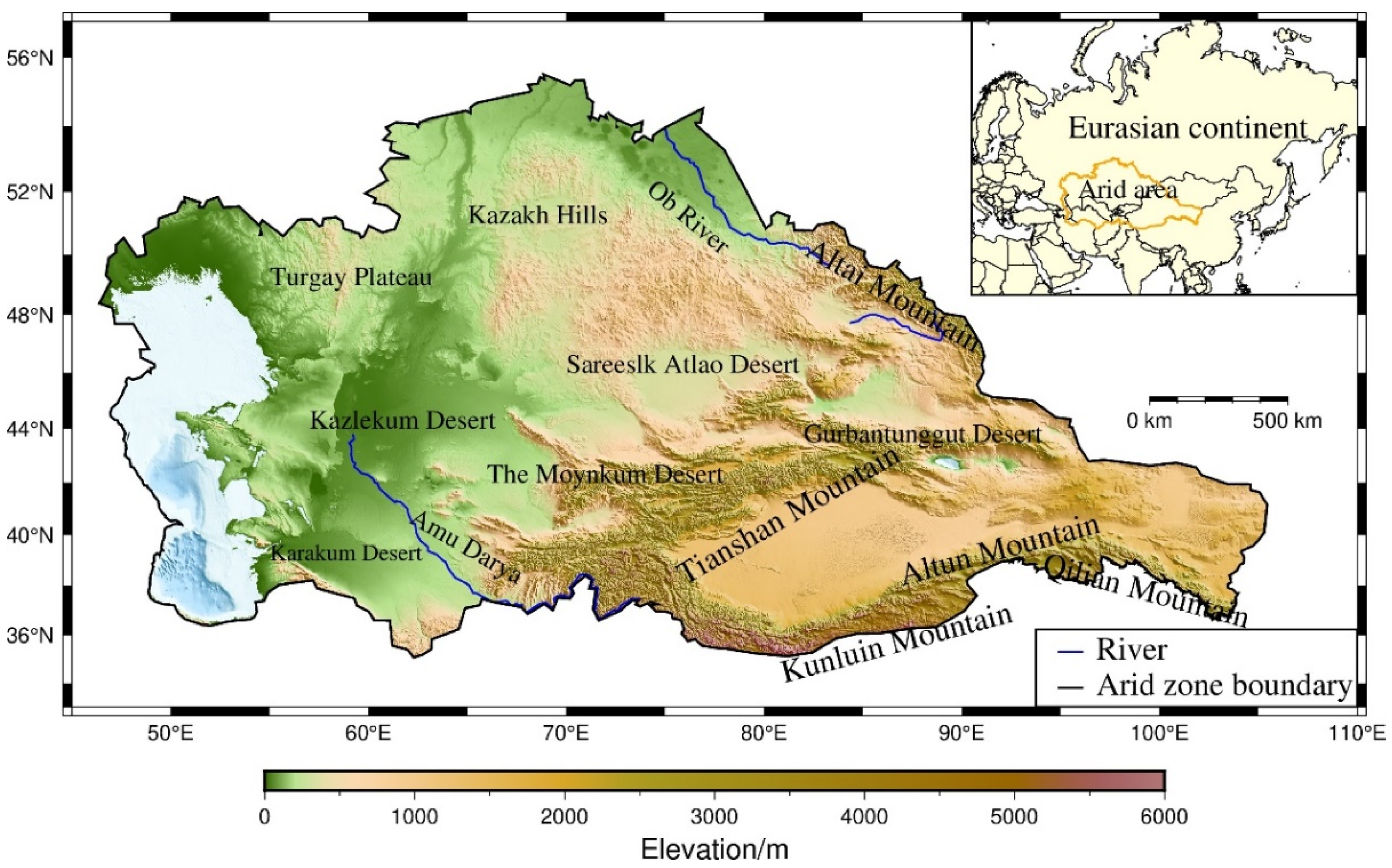
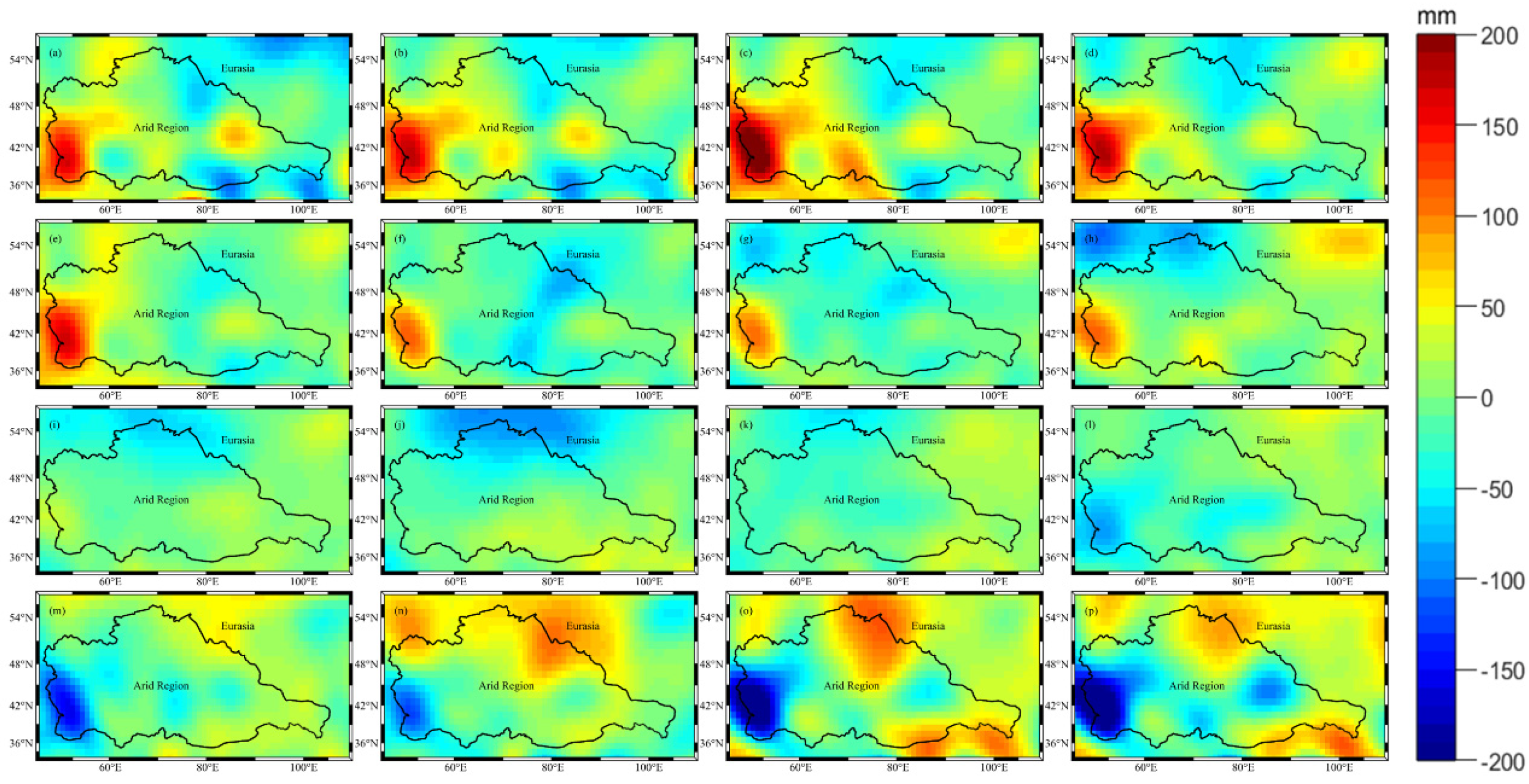
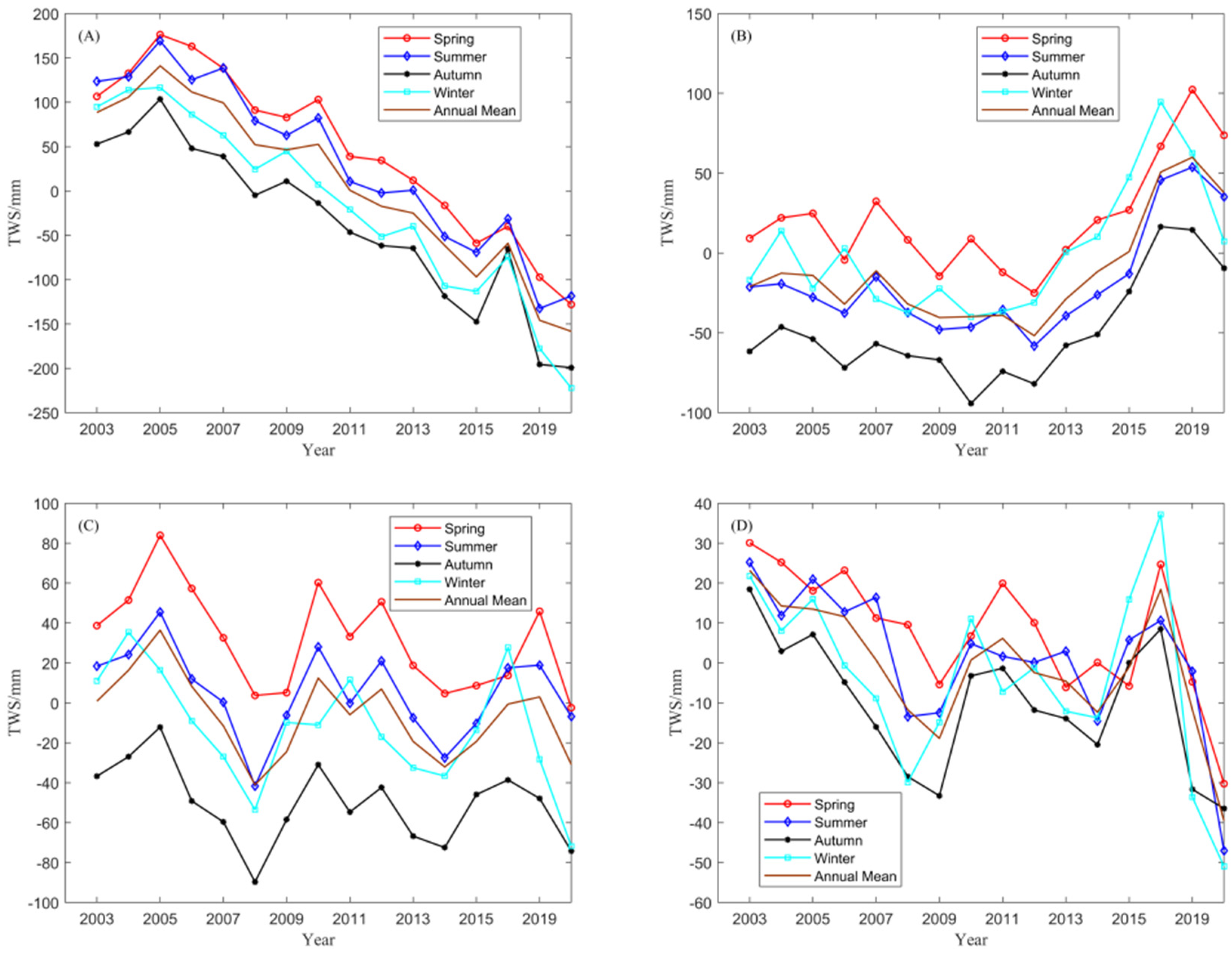
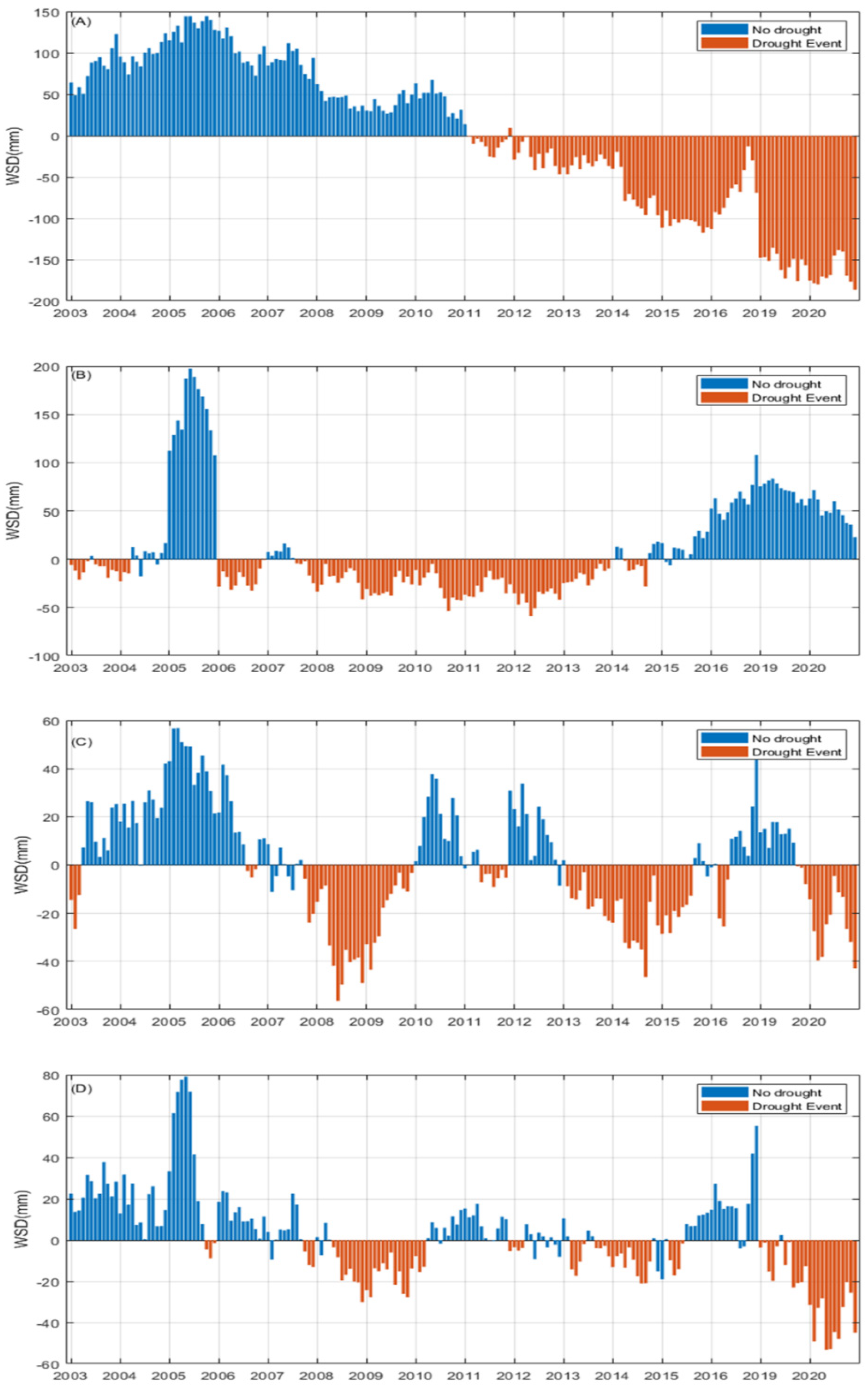
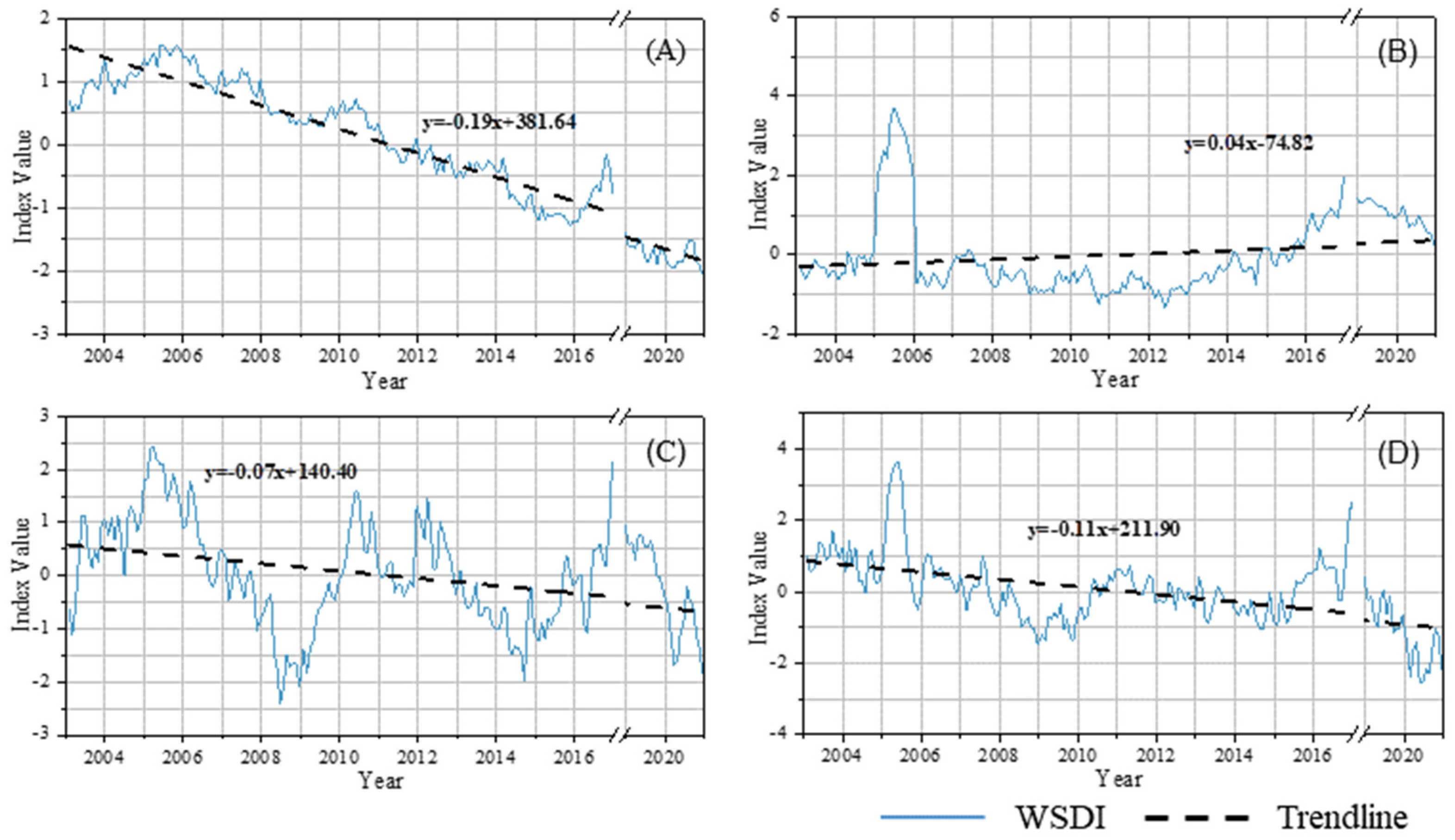
| WSDI Value | Drought Category |
|---|---|
| W > 0 | No drought |
| 0 ≥ W > −1 | Mild drought |
| −1 ≥ W > −2 | Moderate drought |
| −2 ≥ W > −3 | Severe drought |
| −3 ≥ W | Extreme drought |
Publisher’s Note: MDPI stays neutral with regard to jurisdictional claims in published maps and institutional affiliations. |
© 2022 by the authors. Licensee MDPI, Basel, Switzerland. This article is an open access article distributed under the terms and conditions of the Creative Commons Attribution (CC BY) license (https://creativecommons.org/licenses/by/4.0/).
Share and Cite
Liu, J.; Zhu, G.; Zhao, K.; Jiao, Y.; Liu, Y.; Yang, M.; Zhang, W.; Qiu, D.; Lin, X.; Ye, L. GRACE Combined with WSD to Assess the Change in Drought Severity in Arid Asia. Remote Sens. 2022, 14, 3454. https://doi.org/10.3390/rs14143454
Liu J, Zhu G, Zhao K, Jiao Y, Liu Y, Yang M, Zhang W, Qiu D, Lin X, Ye L. GRACE Combined with WSD to Assess the Change in Drought Severity in Arid Asia. Remote Sensing. 2022; 14(14):3454. https://doi.org/10.3390/rs14143454
Chicago/Turabian StyleLiu, Jiawei, Guofeng Zhu, Kailiang Zhao, Yinying Jiao, Yuwei Liu, Mingyue Yang, Wenhao Zhang, Dongdong Qiu, Xinrui Lin, and Linlin Ye. 2022. "GRACE Combined with WSD to Assess the Change in Drought Severity in Arid Asia" Remote Sensing 14, no. 14: 3454. https://doi.org/10.3390/rs14143454
APA StyleLiu, J., Zhu, G., Zhao, K., Jiao, Y., Liu, Y., Yang, M., Zhang, W., Qiu, D., Lin, X., & Ye, L. (2022). GRACE Combined with WSD to Assess the Change in Drought Severity in Arid Asia. Remote Sensing, 14(14), 3454. https://doi.org/10.3390/rs14143454





